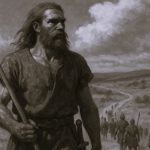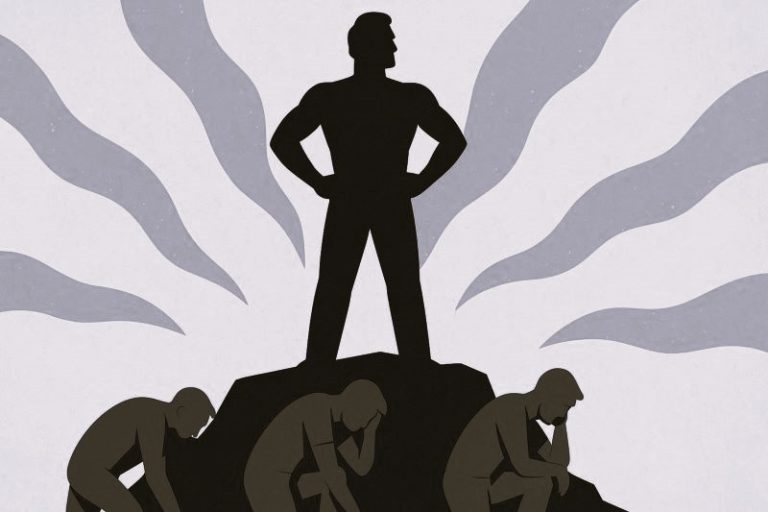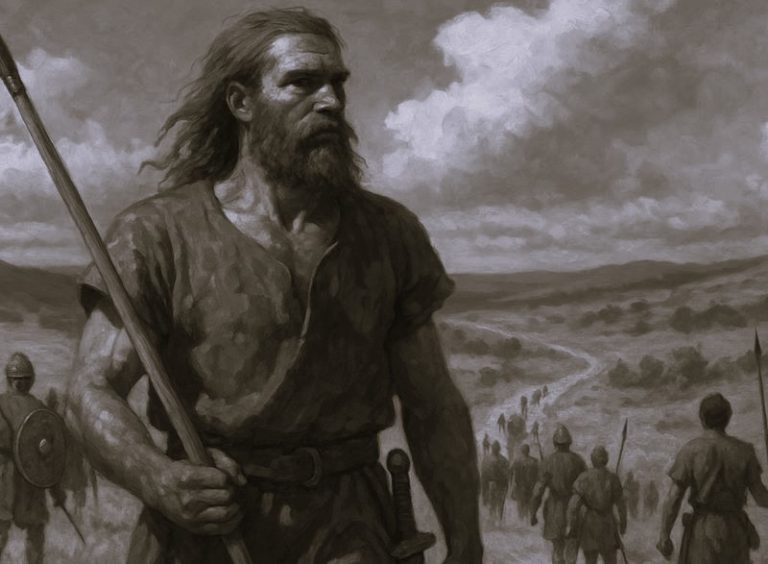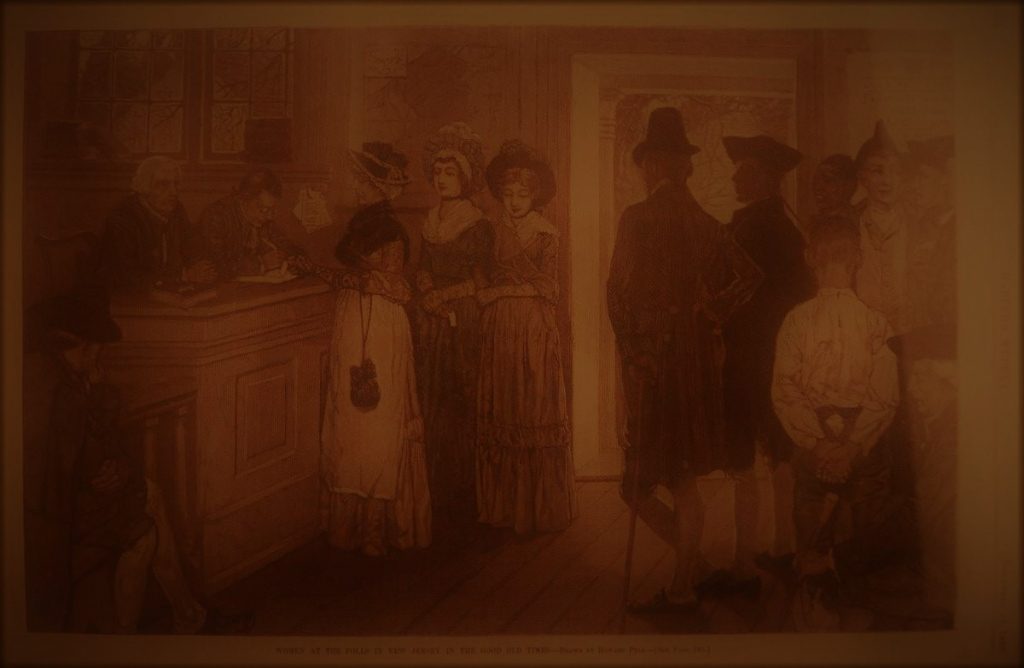

Curated/Reviewed by Matthew A. McIntosh
Public Historian
Brewminate
The Founders and the Vote
In the Declaration of Independence, Thomas Jefferson wrote, “Governments are instituted among Men, deriving their just Powers from the Consent of the Governed.”
But how would Americans consent to be governed? Who should vote? How should they vote? The founders wrestled with these questions. They wondered about the rights of minorities. In their day, that meant worrying if the rights of property owners would be overrun by the votes of those who did not own land. James Madison described the problem this way:
The right of suffrage is a fundamental Article in Republican Constitutions. The regulation of it is, at the same time, a task of peculiar delicacy. Allow the right [to vote] exclusively to property [owners], and the rights of persons may be oppressed… . Extend it equally to all, and the rights of property [owners] …may be overruled by a majority without property….

Eventually, the framers of the Constitution left details of voting to the states. In Article I Section 4, the Constitution says:
The times, places and manner of holding elections for Senators and Representatives, shall be prescribed in each state by the legislature thereof; but the Congress may at any time by law make or alter such regulations.
Unfortunately, leaving election control to individual states led to unfair voting practices in the U.S. At first, white men with property were the only Americans routinely permitted to vote. President Andrew Jackson, champion of frontiersmen, helped advance the political rights of those who did not own property. By about 1860, most white men without property were enfranchised. But African Americans, women, Native Americans, non-English speakers, and citizens between the ages of 18 and 21 had to fight for the right to vote in this country.
Voting Rights for African Americans

A terrible and bloody Civil War freed enslaved Americans. The Fourteenth Amendment to the Constitution (1868) granted African Americans the rights of citizenship. However, this did not always translate into the ability to vote. Black voters were systematically turned away from state polling places. To combat this problem, Congress passed the Fifteenth Amendment in 1870. It says:
The right of citizens of the United States to vote shall not be denied or abridged by the United States or by any state on account of race, color, or previous condition of servitude.
Yet states still found ways to circumvent the Constitution and prevent blacks from voting. Poll taxes, literacy tests, fraud and intimidation all turned African Americans away from the polls. Until the Supreme Court struck it down in 1915, many states used the “grandfather clause ” to keep descendents of slaves out of elections. The clause said you could not vote unless your grandfather had voted — an impossibility for most people whose ancestors were slaves.
This unfair treatment was debated on the street, in the Congress and in the press. A full fifty years after the Fifteenth Amendment passed, black Americans still found it difficult to vote, especially in the South.” What a Colored Man Should Do to Vote“, lists many of the barriers African American voters faced.
The fight for African American suffrage raged on for decades. In the 1930s one Georgia man described the situation this way: “Do you know I’ve never voted in my life, never been able to exercise my right as a citizen because of the poll tax? … I can’t pay a poll tax, can’t have a voice in my own government.”

Many brave and impassioned Americans protested, marched, were arrested and even died working toward voting equality. In 1963 and 1964, Dr. Martin Luther King Jr. brought hundreds of black people to the courthouse in Selma, Alabama to register. When they were turned away, Dr. King organized and led protests that finally turned the tide of American political opinion. In 1964 the Twenty-fourth Amendment prohibited the use of poll taxes. In 1965, the Voting Rights Act directed the Attorney General to enforce the right to vote for African Americans.
The 1965 Voting Rights Act created a significant change in the status of African Americans throughout the South. The Voting Rights Act prohibited the states from using literacy tests and other methods of excluding African Americans from voting. Prior to this, only an estimated twenty-three percent of voting-age blacks were registered nationally, but by 1969 the number had jumped to sixty-one percent.
Voting Rights for Women

Although the Declaration of Independence specifies that “all men are created equal,” its publication sowed the seeds the seeds for the women’s suffrage movement in the United States. The movement took root at an 1840 conference in London, when two determined women met for the first time. Even though they were delegates to the World Anti-Slavery Congress, Lucretia Mott and Elizabeth Cady Stanton could not participate in the convention because they were female. This snub inspired them to work together to guarantee rights for women.

In 1848, Mott and Stanton hosted the Seneca Falls Convention, the first women’s rights convention in the United States. The convention published a Declaration of Sentiments, based on the Declaration of Independence, that called for voting rights for women and other reforms.
Some key grievances included in the Declaration of Sentiments were:
He has never permitted her to exercise her inalienable right to the elective franchise.
He has compelled her to submit to laws, in the formation of which she had no voice.
Having deprived her of this first right of a citizen, the elective franchise, thereby leaving her without representation in the halls of legislation, he has oppressed her on all sides.

Women’s rights conventions were held regularly thereafter. In 1853, Frances Gage presided over the National Women’s Rights Convention in Cleveland, Ohio. She commented on the prevailing opinion that women belonged at home, not at the polling place:
I was asked a few days ago . . . “are you not afraid that woman will run into excesses, that homes will be deserted, that men will lack wives in this country?” I have but one reply to make to that question. Society grants to every man in the United States, every free “white male citizen,” … the privilege of voting, and of being voted for; of being President of the United States; of sitting upon the bench; of filling the jury box, of going to Congress; … and we don’t believe woman will get very far out of her place, if society should yield her the same rights.

Unlike African Americans, who were enfranchised by the Constitution but denied the vote by individual states, women found no help in the Constitution. In fact, the Fourteenth Amendment (1868) defined citizens and voters as “male” – a setback for suffragists. Conflict over how to win the vote in light of Amendments Fourteen and Fifteen split the women’s rights movement.
Susan B. Anthony and Elizabeth Cady Stanton formed the more radical National Woman Suffrage Association (NWSA) that tried to win suffrage at the Constitutional level. NWSA argued that the Fifteenth Amendment, which enfranchised blacks, should be abandoned in favor of a universal suffrage amendment. Anthony herself was arrested in 1872 for trying to vote for Ulysses S. Grant for president.
Lucy Stone, her husband Henry Blackwell, and Julia Ward Howe founded the more moderate American Woman’s Suffrage Association (AWSA). They fought for suffrage on a state by state level. AWSA supported the Fifteenth Amendment and succeeded in winning suffrage for women in several individual states.

In 1890, the two organizations reconciled and became the National American Woman Suffrage Association. By then, women had the right to vote in Wyoming, Utah, Idaho, Colorado and Washington. Armed with strategies from both founding groups, and joined by organizations including the National Association of Colored Women, the National Women’s Party and the National Federation of Women’s Clubs, NAWSA became an influential national force. As a mark of their influence, Theodore Roosevelt’s Bull Moose/Progressive party adopted women’s suffrage as party plank in 1912.
Alice Paul, leader of the National Women’s Party, brought attention-grabbing protest tactics from British suffragists to the United States. In 1917, ten suffragists picketing the White House were arrested while picketing the White House, and charged with obstructing sidewalk traffic.

The suffrage movement slowed during World War I, but women continued to assert their status as full and independent members of society. Since 1878, a women’s suffrage amendment had been proposed each year in Congress. In 1919, the suffrage movement had finally gained enough support, and Congress, grateful for women’s help during the war, passed the Nineteenth Amendment on June 5. With these words, Congress at last removed the legal bar to women’s right to vote:
The right of citizens of the United States to vote shall not be denied or abridged by the United States or by any state on account of sex.
Voting Rights for Native Americans
It’s often overlooked that self-government in America was practiced by Native Americans long before the formation of the United States government. And yet, Native Americans faced centuries of struggle before acquiring full U.S. citizenship and legal protection of their voting rights.
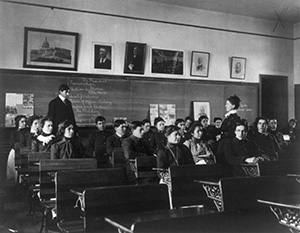
Many government officials felt that Native Americans should be assimilated into America’s mainstream culture before they became enfranchised. The Dawes Act of 1887 was passed to help spur assimilation. It provided for the dissolution of Native American tribes as legal entities and the distribution of tribal lands among individual members (capped at 160 acres per head of family, 80 acres per adult single person) with remaining lands declared “surplus” and offered to non-Indian homesteaders. Among other things, it established Indian schools where Native American children were instructed in not only reading and writing, but also the social and domestic customs of white America.
The Dawes Act had a disastrous effect on many tribes, destroying traditional culture and society as well as causing the loss of as much as two-thirds of tribal land. The failure of the Dawes Act led to change in U.S. policy toward Native Americans. The drive to assimilate gave way to a more hands-off policy of allowing Native Americans the choice of either enfranchisement or self-government.

The Snyder Act of 1924 admitted Native Americans born in the U.S. to full U.S. citizenship. Though the Fifteenth Amendment, passed in 1870, granted all U.S. citizens the right to vote regardless of race, it wasn’t until the Snyder Act that Native Americans could enjoy the rights granted by this amendment.
Even with the passing of this citizenship bill, Native Americans were still prevented from participating in elections because the Constitution left it up to the states to decide who has the right to vote. After the passage of the 1924 citizenship bill, it still took over forty years for all fifty states to allow Native Americans to vote. For example, Maine was one of the last states to comply with the Indian Citizenship Act, even though it had granted tax paying Native Americans the right to vote in its original 1819 state constitution. As reported by Henry Mitchell, a resident of that state, Native Americans were prevented from voting in Maine in the late 1930s.
…[T]he Indians aren’t allowed to have a voice in state affairs because they aren’t voters. …. Just why the Indians shouldn’t vote is something I can’t understand. One of the Indians went over to Old Town once to see some official in the city hall about voting. I don’t know just what position that official had over there, but he said to the Indian, ‘We don’t want you people over here. You have your own elections over on the island, and if you want to vote, go over there.

In 1948, the Arizona Supreme Court struck down a provision of its state constitution that kept Indians from voting. Other states eventually followed suit. Even with the lawful right to vote in every state, Native Americans suffered from the same mechanisms and strategies, such as poll taxes, literacy tests, fraud and intimidation, that kept African Americans from exercising that right. In 1965, with passage of the Voting Rights Act and subsequent legislation in 1970, 1975, and 1982, many other voting protections were reaffirmed and strengthened.
Who Can Vote Today?

As a result of many battles, laws and amendments, modern day voting is a much simpler matter. To vote in a presidential election today, you must be 18 years old, a United States citizen and not a convicted felon. Each state has its own requirements.
Article I, Section 4 of the Constitution provides that “Congress may at any time by law make or alter such regulations” governing elections. Under that provision of Article I, a number of unfair voting practices have been removed, although many Americans remain vigilant about equitable access to the ballot.
Originally published by the United States Library of Congress to the public domain.



